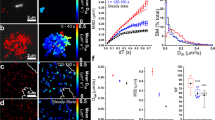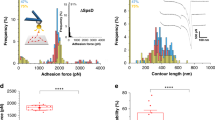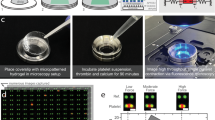Abstract
Bonds between adhesion molecules are often mechanically stressed. A striking example is the tensile force applied to selectin–ligand bonds, which mediate the tethering and rolling of flowing leukocytes on vascular surfaces1,2,3. It has been suggested that force could either shorten bond lifetimes, because work done by the force could lower the energy barrier between the bound and free states4 (‘slip’), or prolong bond lifetimes by deforming the molecules such that they lock more tightly5,6 (‘catch’). Whereas slip bonds have been widely observed7,8,9,10,11,12,13,14, catch bonds have not been demonstrated experimentally. Here, using atomic force microscopy and flow-chamber experiments, we show that increasing force first prolonged and then shortened the lifetimes of P-selectin complexes with P-selectin glycoprotein ligand-1, revealing both catch and slip bond behaviour. Transitions between catch and slip bonds might explain why leukocyte rolling on selectins first increases and then decreases as wall shear stress increases9,15,16. This dual response to force provides a mechanism for regulating cell adhesion under conditions of variable mechanical stress.
This is a preview of subscription content, access via your institution
Access options
Subscribe to this journal
Receive 51 print issues and online access
$199.00 per year
only $3.90 per issue
Buy this article
- Purchase on SpringerLink
- Instant access to full article PDF
Prices may be subject to local taxes which are calculated during checkout




Similar content being viewed by others
References
Vestweber, D. & Blanks, J. E. Mechanisms that regulate the function of the selectins and their ligands. Physiol. Rev. 79, 181–213 (1999)
McEver, R. P. & Cummings, R. D. Perspectives series: cell adhesion in vascular biology. Role of PSGL-1 binding to selectins in leukocyte recruitment. J. Clin. Invest. 100, 485–491 (1997)
McEver, R. P. Adhesive interactions of leukocytes, platelets, and the vessel wall during hemostasis and inflammation. Thromb. Haemost. 86, 746–756 (2001)
Bell, G. I. Models for the specific adhesion of cells to cells. Science 200, 618–627 (1978)
Dembo, M., Tourney, D. C., Saxman, K. & Hammer, D. The reaction-limited kinetics of membrane-to-surface adhesion and detachment. Proc. R. Soc. Lond. B 234, 55–83 (1988)
Dembo, M. Lectures on Mathematics in the Life Sciences, Some Mathematical Problems in Biology 51–77 (American Mathematical Society, Providence, Rhode Island, 1994)
Alon, R., Hammer, D. A. & Springer, T. A. Lifetime of the P-selectin–carbohydrate bond and its response to tensile force in hydrodynamic flow. Nature 374, 539–542 (1995)
Pierres, A., Benoliel, A. M., Bongrand, P. & van der Merwe, P. A. Determination of the lifetime and force dependence of interactions of single bonds between surface-attached CD2 and CD48 adhesion molecules. Proc. Natl Acad. Sci. USA 93, 15114–15118 (1996)
Alon, R., Chen, S., Puri, K. D., Finger, E. B. & Springer, T. A. The kinetics of L-selectin tethers and the mechanics of selectin-mediated rolling. J. Cell Biol. 138, 1169–1180 (1997)
Chen, S. & Springer, T. A. An automatic braking system that stabilizes leukocyte rolling by an increase in selectin bond number with shear. J. Cell Biol. 144, 185–200 (1999)
Smith, M. J., Berg, E. L. & Lawrence, M. B. A direct comparison of selectin-mediated transient, adhesive events using high temporal resolution. Biophys. J. 77, 3371–3383 (1999)
Ramachandran, V. et al. Dimerization of a selectin and its ligand stabilizes cell rolling and enhances tether strength in shear flow. Proc. Natl Acad. Sci. USA 98, 10166–10171 (2001)
Chen, S. & Springer, T. A. Selectin receptor–ligand bonds: Formation limited by shear rate and dissociation governed by the Bell model. Proc. Natl Acad. Sci. USA 98, 950–955 (2001)
Merkel, R., Nassoy, P., Leung, A., Ritchie, K. & Evans, E. Energy landscapes of receptor–ligand bonds explored with dynamic force spectroscopy. Nature 397, 50–53 (1999)
Finger, E. B. et al. Adhesion through L-selectin requires a threshold hydrodynamic shear. Nature 379, 266–269 (1996)
Lawrence, M. B., Kansas, G. S., Kunkel, E. J. & Ley, K. Threshold levels of fluid shear promote leukocyte adhesion through selectins (CD62L,P,E). J. Cell Biol. 136, 717–727 (1997)
Geng, J.-G. et al. Rapid neutrophil adhesion to activated endothelium mediated by GMP-140. Nature 343, 757–760 (1990)
Moore, K. L. et al. The P-selectin glycoprotein ligand from human neutrophils displays sialylated, fucosylated, O-linked poly-N-acetyllactosamine. J. Biol. Chem. 269, 23318–23327 (1994)
Yago, T. et al. Distinct molecular and cellular contributions to stabilizing selectin-mediated rolling under flow. J. Cell Biol. 158, 787–799 (2002)
Moore, K. L. et al. P-selectin glycoprotein ligand-1 mediates rolling of human neutrophils on P-selectin. J. Cell Biol. 128, 661–671 (1995)
Moore, K. L., Varki, A. & McEver, R. P. GMP-140 binds to a glycoprotein receptor on human neutrophils: evidence for a lectin-like interaction. J. Cell Biol. 112, 491–499 (1991)
Chen, S., Alon, R., Fuhlbrigge, R. C. & Springer, T. A. Rolling and transient tethering of leukocytes on antibodies reveal specializations of selectins. Proc. Natl Acad. Sci. USA 94, 3172–3177 (1997)
Ushiyama, S., Laue, T. M., Moore, K. L., Erickson, H. P. & McEver, R. P. Structural and functional characterization of monomeric soluble P-selectin and comparison with membrane P-selectin. J. Biol. Chem. 268, 15229–15237 (1993)
Fritz, J., Katopodis, A. G., Kolbinger, F. & Anselmetti, D. Force-mediated kinetics of single P-selectin/ligand complexes observed by atomic force microscopy. Proc. Natl Acad. Sci. USA 95, 12283–12288 (1998)
Leppänen, A., White, S. P., Helin, J., McEver, R. P. & Cummings, R. D. Binding of glycosulfopeptides to P-selectin requires stereospecific contributions of individual tyrosine sulfate and sugar residues. J. Biol. Chem. 275, 39569–39578 (2000)
Somers, W. S., Tang, J., Shaw, G. D. & Camphausen, R. T. Insights into the molecular basis of leukocyte tethering and rolling revealed by structures of P- and E-selectin bound to SLe(X) and PSGL-1. Cell 103, 467–479 (2000)
Isberg, R. R. & Barnes, P. Dancing with the host; flow-dependent bacterial adhesion. Cell 110, 1–4 (2002)
Hutter, J. L. & Bechhoefer, J. Calibration of atomic-force microscope tips. Rev. Sci. Instrum. 64, 1868–1873 (1993)
McConnell, H. M., Watts, T. H., Weis, R. M. & Brian, A. A. Supported planar membranes in studies of cell–cell recognition in the immune system. Biochim. Biophys. Acta 864, 95–106 (1986)
Wong, J. Y. et al. Polymer-cushioned bilayers. I. A structural study of various preparation methods using neutron reflectometry. Biophys. J. 77, 1445–1457 (1999)
Acknowledgements
We thank V. Moy for providing the AFM design and training. This work was supported by grants from the National Institutes of Health.
Author information
Authors and Affiliations
Corresponding author
Ethics declarations
Competing interests
The authors declare that they have no competing financial interests.
Rights and permissions
About this article
Cite this article
Marshall, B., Long, M., Piper, J. et al. Direct observation of catch bonds involving cell-adhesion molecules. Nature 423, 190–193 (2003). https://doi.org/10.1038/nature01605
Received:
Accepted:
Issue Date:
DOI: https://doi.org/10.1038/nature01605
This article is cited by
-
De novo DNA-based catch bonds
Nature Chemistry (2024)
-
Catch bond models may explain how force amplifies TCR signaling and antigen discrimination
Nature Communications (2023)
-
High-force catch bonds between the Staphylococcus aureus surface protein SdrE and complement regulator factor H drive immune evasion
Communications Biology (2023)
-
Biomechanical activation of blood platelets via adhesion to von Willebrand factor studied with mesoscopic simulations
Biomechanics and Modeling in Mechanobiology (2023)
-
Maximizing flow rate in single paper layer, rapid flow microfluidic paper-based analytical devices
Microfluidics and Nanofluidics (2023)



